American Beautyberry (Callicarpa americana) is a remarkable plant native to the southeastern United States. It is best known for its display of vibrant purple berries that cluster along the branches.
This deciduous Texas native shrub can reach an average height of 3 to 6 feet, adding a pop of color to gardens and landscapes. The beautyberry's foliage consists of glossy, elliptical leaves that transition from green to yellow in the fall. This plant is aesthetically pleasing and attracts a variety of wildlife, including birds and butterflies, making it a valuable addition to any Texas landscape.
Common Name(s): Beautyberry, American Beautyberry, French Mulberry
Height: 3 - 5' and 3 - 5' wide can reach as tall as 9'
Soil Conditions: Prefers the moist soils of canyons, bottomlands, woods, and stream banks.
Water: Low, although the beautyberry might enjoy some water in peak summer months. Consider putting the beautyberry near moister parts of your landscape (e.g., near A/C condensation drain lines, gutter downspouts, etc.).
Light: Shade/Part Shade. It can tolerate some sun, but significant enough sun might cause the beautyberry to wilt during peak summer months. My recommendation: Shade is best, but the spotted sun (during the summer) can be just fine, too.
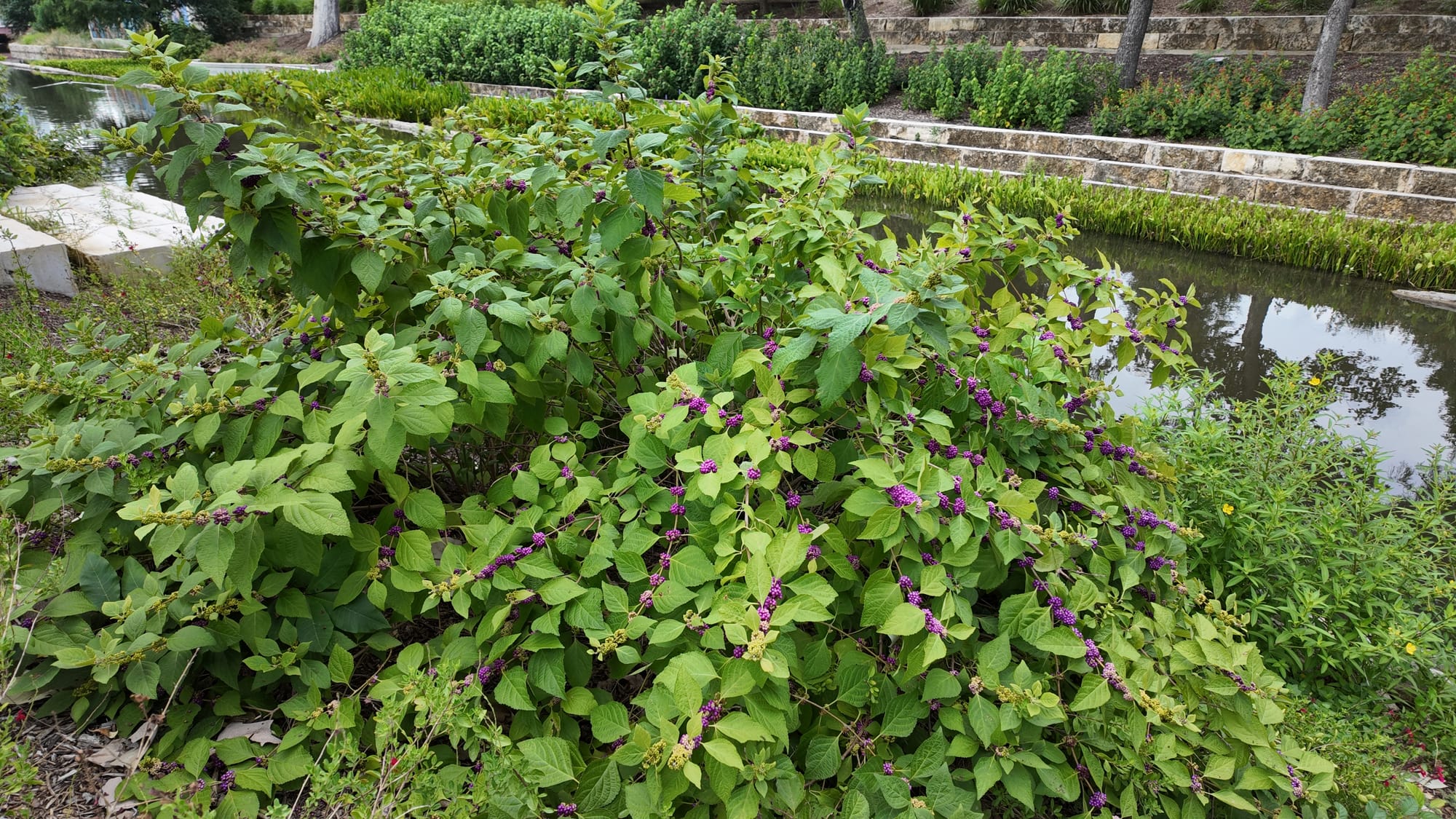
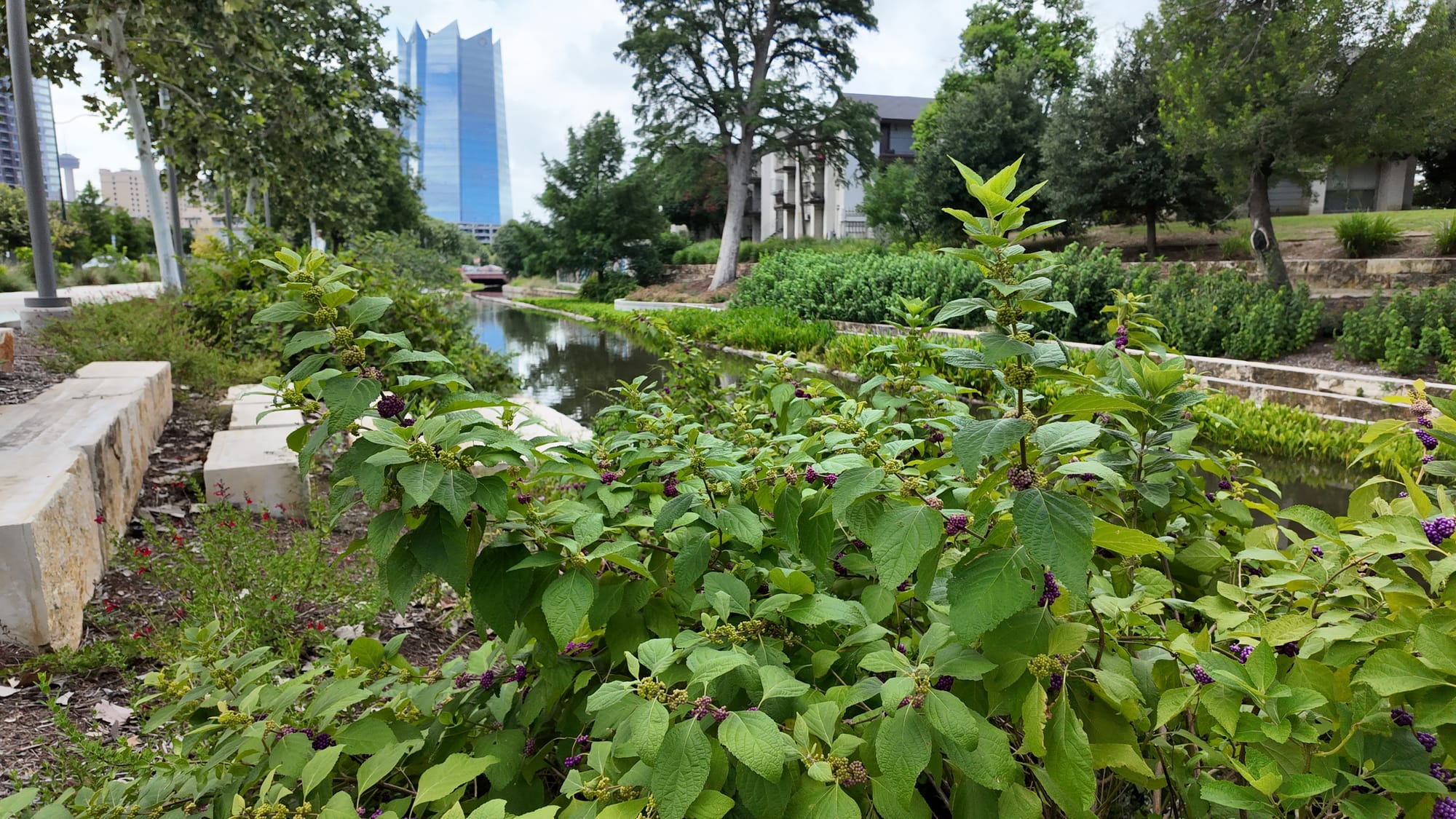
American Beautyberry along San Pedro Springs Creek in San Antonio, TX.
Distribution:
Where is American Beautyberry Native?
The American Beautyberry is native from Central Texas east, up the East Coast as far as Maryland. Some iNaturalist user observations show the American Beautyberry has been identified even a bit further north.
The American Beautyberry can also be found in South Florida, Bermuda, and Cuba.
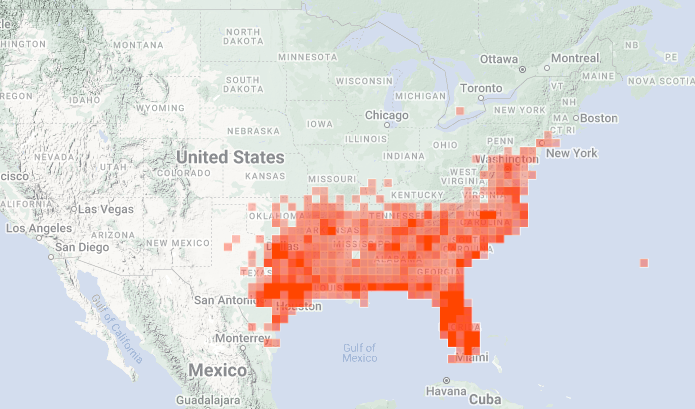
As for Texas, the American Beautyberry is mainly distributed to East Texas. In dense concentrations, it's found rarely west of San Antonio. This is most likely due to Beautyberry's preference for moister, shadier landscapes.
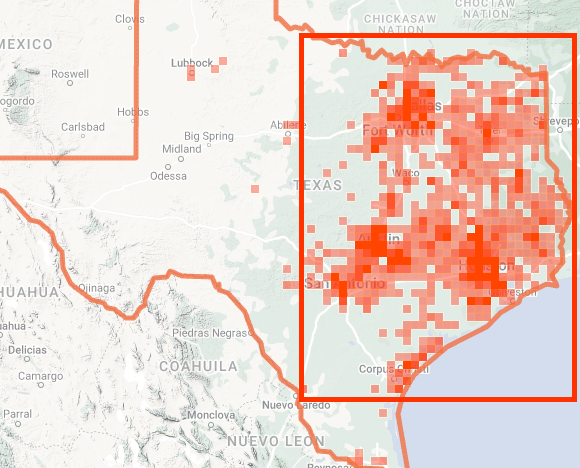
The Benefits of American Beautyberry:
For Your Landscape:
- Great in Understory Shade–The American Beautyberry is a native plant of Texas that will thrive in the shade. Much of our property (thankfully) is covered by the canopies of beautiful, mature live oak trees. With much shaded and partially shaded understory to fill, the Beautyberry has been a welcome addition to our landscape.
- Visibly Attractive Flowers and Colorful Fruit–The Beautberries themselves are a bright magenta color that catches the eye, and the flowers before them are bright pink. Matched with full green leaves in late summer/fall, the Beautyberries are a visually exciting plant, I think, to add to the landscape.
- Attracts Wildlife–The Beautyberries are a welcome food source for many birds (see more below) during the late summer and fall.
- Low Maintenance (if in the right spot)–As long as the Beautyberry is placed in the right spot (mostly shade and greater relative moisture for your property), you shouldn't have to think about it much. If it wilts during the summer, you can give it some supplemental water, especially if it's a newer plant.
- Edible Berries–The berries are edible! Provided you have enough Beautyberries, you can make jams, jellies, wines, and salad dressing. Remember always to leave some for the wildlife, though.
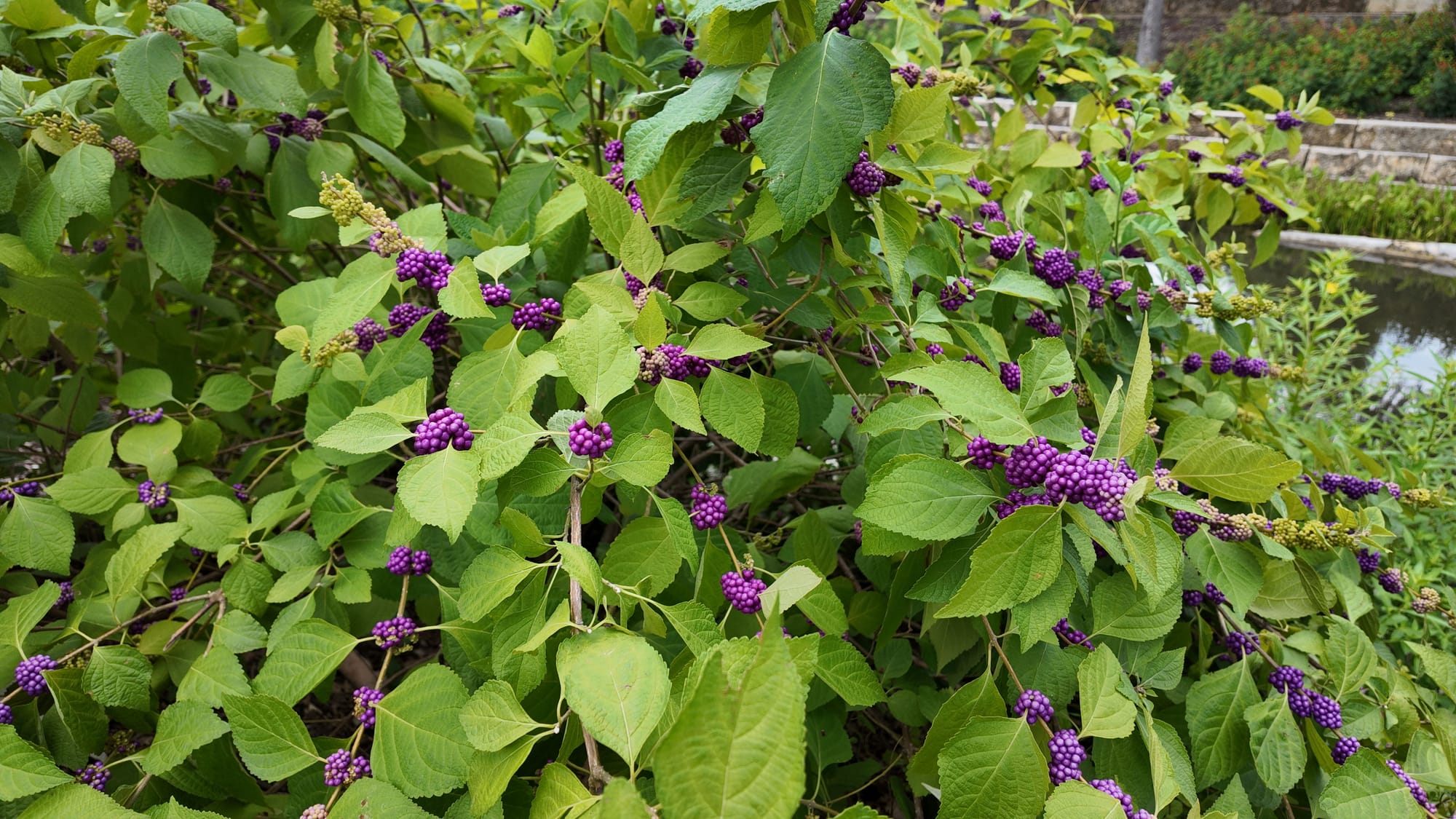
For Wildlife:
- Food Source (Late Summer/Fall/Early Winter)–Many birds favor the beautyberries: bobwhites, mockingbirds, cardinals, thrashers, robins, finches, and towhees. Even small mammals like opossums, raccoons, and gray foxes have also been known to eat them.
Planting & Care:
Where to Plant: The American Beautyberry is best planted in the shade of your landscape, even better, where you know it to be on the more moist side. I've planted my beautyberries in known shade/partial shade spots in my landscape. They are a great edge or background plant, so I have them lining my porch, a fence line, and underneath the shade line of the house awning.
I've also strategically placed them where they can get extra runoff or drip in rain events (e.g., next to the driveway for runoff, runoff from an uncluttered roof, and then near a gutter downspout.
The American Beautyberry has become a more popular planting in our city landscapes here in San Antonio (which I'm very happy about). We have incredibly impressive Beautyberry shrubs lining the water near our recently opened San Pedro Springs Culture Park. I do have to imagine those shrubs receive some extra watering, though.
So, thinking of where to place a Beautyberry for yourself:
- Shade
- Higher than average moisture level or poorly draining soil (or chance for higher than average water retention)
- Edges
And if you get this wrong, don't worry! You can always move them. I forgot about the intensity of a summer sun in a spot that's entirely shaded in the winter and I was forced to transplant two beautyberries that were getting scorched in the dead of summer. That's not to say I recommend that, but to show that all is not lost on mischosen location, I transplanted two plants successfully. It was already too late for the third. 😬
Care/Maintenance: Caring for a Beautyberry should be easy if the location is correctly chosen. You can prune back the Beautyberry each winter by half its height to encourage tighter growth, more flowers, and fruit (but you don't have to).
As for establishing the plant, my plants wilted quite significantly in year one during the peak summer heat, and to ensure their survival, I watered them 1-2 times per week. However, in year two, I've had to give the plants a fraction of the supplemental water that I did in year one–maybe a single watering every few weeks.
However, the plants I have in more consistent shade have occasionally looked wilty, but I haven't given them any extra water at all in year two.
Companion Plants: Good companion plants for the American Beautyberry are Pigeonberry, Coralberry, Wood Fern, and Texas Betony. The American Beautyberry can be planted under a number of larger shade trees: Pecan, Live Oak, or Mesquite.
Seasons: What to Expect
Spring: New leaves begin to emerge, and by the time spring is over, full leaves should be established, and you may even start to see Beautyberries begin to bloom.
Summer: Beautyberry flowers should be in full bloom come summertime in tight clusters called cymes, in a light white-ish pink-ish color. It is not uncommon to see the Beautyberry leaves droop during peak periods of heat, which, unfortunately for the landscape, can be unattractive. This is why I prefer the Beautyberries I planted in full shade versus partial shade/sun (less likely to droop in summer).
Depending on the location (more sun, typically), Beautyberries can start to bear their fruit!
Fall: Early fall is when Beautyberry puts on its show. This is when Beautyberries begin to fruit and ripen into the vibrant magenta color while still having bright green full leaves.
Winter: If the Beautyberries haven't been harvested or eaten by wildlife, they will continue to hang onto the branch through winter. As the Beautyberry is deciduous, the leaves will fall, and the plant will now look twiggy through the winter. In late winter, you could prune your Beautyberry to half its overall height and wait for spring.
Medicinal/Edible Uses:
- Edible Berries–When the Beautyberries are fully ripe (when they are the deep purple/magenta color), they are ready to be harvested and can be eaten raw. However, it's best to not eat too many as it can cause stomach upset. Beautyberries can be cooked and made into jams and jellies, even wine! Foraging Texas even lists a fruity "Beautyberry Salad Dressing" recipe I'll have to try someday and share here.
- Mosquito Repellent–What was once confirmed just to be a folk remedy, was confirmed a few years back by researchers at the University of Mississippi. Compounds found in the leaves of American Beautyberry can repeal mosquitos. Just crush up the leaves and rub them on your skin.
Propagation:
- From Seed - According to How to Grow Native Plants of Texas and the Southwest, American Beautyberry seeds can be sown in a greenhouse in November and will germinate in January and February, ready to be planted in the landscape come April.
- From Cuttings - American Beautyberry can be propagated from softwood and hardwood cuttings. It's recommended to take the softwood cuttings roughly May through June right after the first growth of the season, but before the plants have flowered. These cuttings should be 4-5 inches long and treated with rooting hormone. All leaves should be removed from the bottom of the cuttings. These cuttings can root in 7-14 days. Hardwood cuttings taken in winter (when you prune) should be 5-8 inches long and likewise treated with rooting hormone and kept under intermittent mist.
- Transplanting–You can get more American Beautyberry by separating clumps from mature plants during the dormant season. Beautyberry is easily transplanted, provided it's cut back by at least two-thirds and well watered (preferably transplanted to shade).

American Beautyberry FAQs:
- Are American Beautyberries edible or toxic? American Beautyberries are edible and can be eaten raw, although expert foragers advise eating them in small quantities. They can also be cooked, eliminating any risk of stomach upset.
- Are American Beautyberries messy? No, the berries are small and remain largely intact even if they fall from the plant (which is rare). Avoid planting them where the berries could fall on pavement, however, and there should be no concern whatsoever about the mess.
- What are the problems with American Beautyberry? If you don't like the look of the plant when it droops in peak summer, or if it is placed somewhere where it can get too dry, it might not thrive or die.
Sources:
Along with my own experience working with American Beautyberry in my landscape and learning from my observations out in Texas' natural places, here are all the books that I consulted in producing this page:
📚 Books
- Edible and Useful Plants of the Southwest: Texas, New Mexico, and Arizona by Delena Tull
- Foraging Texas: Finding, Identifying, and Preparing Edible Wild Foods in Texas by Eric M. Knight and Stacy M. Coplin
- How to Grow Native Plants of Texas and The Southwest by Jill Nokes
- Texas Wildcapes: Gardening for Wildlife by Noreen Damude and Kelly Conrad Bender
- Native Texas Plants: Landscaping Region by Region by Sally and Andy Wasowski
🌐 Websites
- (n.d.). Callicarpa americana. Lady Bird Johnson Wildflower Center. https://www.wildflower.org/plants/result.php?id_plant=caam2

